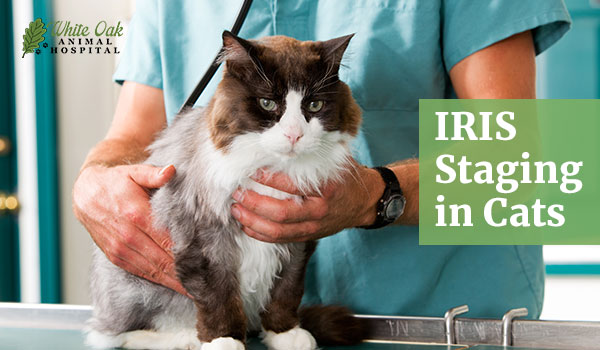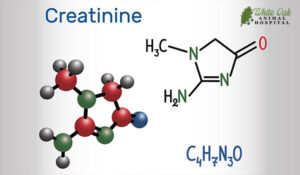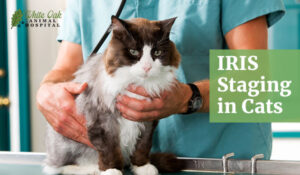
IRIS staging in cats is something we use regularly at White Oak Animal Hospital. It helps us decide which labs to run, how often to monitor, and which supportive therapies to offer. That might mean we turn to Western options like blood pressure meds, or it might mean Eastern tools like herbal kidney support or appetite-focused acupuncture. This staging system helps us move faster and smarter before symptoms get worse.
Chronic kidney disease is one of the most common long-term conditions in cats. Many cases go unnoticed until the disease is well underway. Cats tend to compensate until symptoms are apparent; damage may already be advanced by then. This is where IRIS staging in cats comes in. It allows us to detect kidney disease early, track its progression, and build care plans based on measurable changes.
IRIS Staging in Cats: What It Is and Why It Matters
 IRIS staging in cats is a medical framework created by the International Renal Interest Society. It organizes chronic kidney disease into four stages based on how far the kidneys have declined. We stage cats based on creatinine, SDMA, protein in the urine, phosphorus levels, and blood pressure.
IRIS staging in cats is a medical framework created by the International Renal Interest Society. It organizes chronic kidney disease into four stages based on how far the kidneys have declined. We stage cats based on creatinine, SDMA, protein in the urine, phosphorus levels, and blood pressure.
Stage 1 usually means the kidneys look okay on standard labs, but something isn’t right. The SDMA might be elevated, or the urine may show excess protein. These cats may act completely normal. Stage 2 often brings mild increases in creatinine or SDMA and early signs like more thirst or extra trips to the litter box. Stage 3 means more significant changes. Appetite drops, weight loss begins, and vomiting might show up. Stage 4 is severe. These cats are usually weak, dehydrated, and losing muscle fast.
Using IRIS staging in cats helps us choose the right actions at the right time. We might switch food to a kidney-safe diet in Stage 2. We might start acupuncture in Stage 3 to support appetite and reduce nausea. In Stage 4, we might focus on comfort and quality of life with fluids for hydration and energy.
This system keeps us focused. It replaces vague labels like “early” or “advanced” with measurable stages directly linking to treatment choices.
5 Warning Signs It’s Time to Test Kidney Function
Some signs of kidney disease are easy to miss. Others get mistaken for normal aging. Here are five that should make you consider IRIS staging in cats:
 Your cat may drink or pee more than usual. You might notice weight loss even when their appetite looks normal. Sometimes, they sniff food but leave it. Vomiting or nausea might come and go. They may hide and sleep more, or their coats look dull or greasy.
Your cat may drink or pee more than usual. You might notice weight loss even when their appetite looks normal. Sometimes, they sniff food but leave it. Vomiting or nausea might come and go. They may hide and sleep more, or their coats look dull or greasy.
IRIS staging in cats is often the only way to confirm if these symptoms are connected to kidney decline. Catching these signs early makes a difference. Testing gives us a baseline, and the IRIS stages help us match treatment to the actual level of disease—not just the symptoms.
Integrative Support for Cats in Every IRIS Stage
Western treatment for kidney disease usually focuses on diet, blood pressure, and hydration. Those are important. But IRIS staging in cats allows us to go further. White Oak Animal Hospital uses these stages to guide herbal therapy, food therapy, acupuncture, and even remote support through telemedicine.
In Stage 1 or 2, we often focus on prevention. We might use TCVM herbs to support kidney qi and improve circulation. We also adjust the diet, using food therapy to cool inflammation or support fluids depending on the pattern. If blood pressure is elevated, we address it early with Western or Eastern tools.
 Stage 3 brings more symptoms. Nausea, dehydration, and appetite loss are common. This is where acupuncture helps. We use specific points to improve stomach function, reduce nausea, and support energy. Herbs might include formulas for fluid retention or tonics for yang deficiency, depending on the cat. Diet adjustments become more tailored; we often add hydration strategies like subcutaneous fluids.
Stage 3 brings more symptoms. Nausea, dehydration, and appetite loss are common. This is where acupuncture helps. We use specific points to improve stomach function, reduce nausea, and support energy. Herbs might include formulas for fluid retention or tonics for yang deficiency, depending on the cat. Diet adjustments become more tailored; we often add hydration strategies like subcutaneous fluids.
Stage 4 often shifts the goal to comfort. These cats may not tolerate aggressive care. We use gentle acupuncture to relieve discomfort and restore some appetite. Herbal medicine might help with low energy or dry stools. Sometimes, we use telemedicine to adjust herbs and diet without frequent in-person visits.
IRIS staging in cats makes all this possible. It tells us where to start and what to expect. It helps us avoid blanket treatments and replace them with focused care.
IRIS staging in cats gives us a better way to manage kidney disease. It replaces guesswork with data, and it helps us catch problems earlier than symptoms alone would allow. From mild thirst changes to clear signs like vomiting or muscle loss, every stage gives us something to work with.
At White Oak Animal Hospital, we use IRIS staging in cats to decide, in conjunction with you, what your cat needs, when they need it, and how to make care more manageable. That might include herbs, acupuncture, hydration support, food therapy, or Western medicine. It depends on the stage, the symptoms, and what your cat tolerates.
 We’ve been treating kidney disease for more than 28 years, and our approach is built on flexibility. When a scan or lab points to a problem, we act with the care that fits your cat’s condition and personality. We can also follow up through telemedicine when travel is hard.
We’ve been treating kidney disease for more than 28 years, and our approach is built on flexibility. When a scan or lab points to a problem, we act with the care that fits your cat’s condition and personality. We can also follow up through telemedicine when travel is hard.
If you’ve noticed changes in thirst, appetite, or energy, it may be time to test. IRIS staging isn’t about labels. It’s about giving your cat a better chance at stability, comfort, and quality of life.
Frequently Asked Questions
How is IRIS staging in cats different from just running bloodwork?
A single lab value doesn’t tell the whole story. IRIS staging in cats pulls together multiple test results—creatinine, SDMA, urine protein, phosphorus, and blood pressure. That gives a more complete picture. It helps us tell the difference between temporary changes and actual kidney disease.
Can cats with Stage 1 or 2 kidney disease live everyday lives?
Yes. When caught early, most Stage 1 or 2 cats live well for years. We use herbs, diet adjustments, hydration, and acupuncture to slow things down. Routine checkups let us track changes and make timely updates.
How often should IRIS staging be repeated?
That depends on the stage and how stable your cat is. In the early stages, every six months is typical. In more advanced stages, we might repeat tests every two to three months to watch for shifts in appetite, weight, or hydration needs.
Do you offer herbs or acupuncture for kidney disease in cats?
Yes. We use TCVM herbs that support kidney function and ease related symptoms. Acupuncture helps with digestion, appetite, and energy. We base treatment on the IRIS stage and your cat’s pattern in TCVM—not a one-size-fits-all plan.
Can I get an IRIS staging update through a telemedicine visit?
Yes. If recent lab work is available, we can review it remotely. We’ll review the results, adjust herbs or diet as needed, and follow up based on how your cat is doing. This is helpful for cats who don’t travel well or need frequent updates.
Related Posts
-
Mouth Cancer in Cats: 5 Common Symptoms and Signs You Shouldn't Ignore
Our pets, like humans, can suffer from various dental issues, and mouth cancer in cats…
-
5 Warning Signs That May Require Cat Eye Surgery
Cat eye surgery can be life-saving when severe eye conditions threaten your cat’s vision. A…
-
Top 5 Signs Your Dog May Have a Dog Torn Knee Ligament: Stay Alert
Recognizing the signs of a dog torn knee ligament is paramount for pet owners.…
-
Food Therapy for Cats
Could your feline benefit from food therapy for cats? Yes! In fact, you can help…









